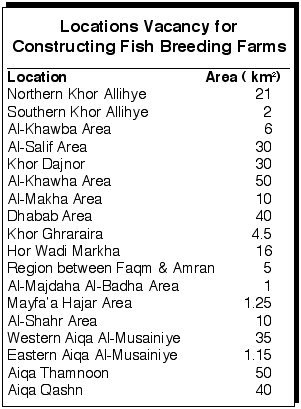
Briefing on the Yemen’s Artificial Fish Breeding The Center for Growing Sea Creatures [Archives:2001/14/Business & Economy]
April 2 2001
In the latest reports of the Food and Agriculture Organization (FAO), it has been indicated that the average production of fisheries from seas, rivers and lakes is gradually declining. The statistics show that the decline in production, starting from the sixties to the nineties, has been quite high, ranging from 7.4% in the sixties to 0.5% in the nineties. The main reason, reports say, behind this is the over-fishing of commercial fish which started intensively in the sixties and continues today. This leads to an imbalance in the natural habitat of creatures living in the sea as it affected the hunted fish directly, as well as the fish that used to feed on the hunted fish indirectly. The environmental imbalance caused by over-fishing has had an adverse effect on the quantity of fish of all kinds all over the world.
This eventually brings into focus the importance of artificial fish breeding to compensate for the commercial types of fish, and increase their production through establishing several fish breeding plantations.
Artificial fish breeding has increased rapidly from 6.9 tons of artificially bred fish in 1984 to 15.8 million tons in 1992, which indicates an annual increase of about 9%.
The artificial fish breeding industry simply means more production of sea creatures by breeding them in artificial environment similar to their natural habitat in order to increase their numbers and continue their life cycles. This results in the increase of the increased artificial production allows them to recover from the over-fishing in their natural habitat.
Artificial Fish Breeding Experience at the CGSC
The Center for Growing Sea Creatures (CGSC) was inaugurated in the Ghadeer area in Little Aden (in Aden City) in April 1988 as a result of the cooperation between the then South Yemen government and the government of Japan. Japan was represented by the Japan International Cooperation Association. The aim of the center was to continue with research and experiments in the field of artificial breeding of sea creatures, which had already started in 1979 in the form of a small research station at the Ummal island, and then taken to the Al-Farisi region in Little Aden. In order to develop artificial fish breeding, the center has been carrying out different breeding experiments of different sea creatures, and according to the results, it continued to enhance its productivity.
The center focused on commercial fish which are being successfully bred in many countries around the world. These include shrimp and other types of fish which have great demand in the markets. The experiments at the center resulted in reasonably good results, particularly in the breeding of the coastal shrimp species Penaeus Indicus and Penaeus Smisulcatus as more than 220,000 were produced in 1989 alone. In commercial terms, more than 100,000 fully grown shrimps have been marketed resulting in greater revenue, particularly in 1992 and 1993. There were however some political events resulting in the suspension of the activities of the center, including the 1991 Gulf War and the 1994 civil war. Today however, the center is expanding and progressing in developing its breeding experiments and solving the technical difficulties which had been causing obstacles in the past, especially after the microscopic seaweed and moss became available.
In the field of artificial fish breeding, the center faced a lot of difficulties as it was unable to breed fish except for the species of Sparus Sarba due to the lack of the appropriate food type required (Rotifera). Hence, efforts must focus on finding new ways to produce the food essential for the breeding and growing of commercial fish.
Future Research prospects at the Center
The future prospects of research of the center can be summarized as follows:
1- Carrying out experiments and researches to artificially breed commercially demanded sea creatures such as shrimp (P. Indicus & P. Semisulcatus), lobster, and other types of fish. It is important to make sure the species will grow healthy and reach the stage of marketability with reasonable cost effectiveness. Future efforts should concentrate on breeding P. Manadon & Japonicus) and finding the best of ways to breed them.
2- Carrying out research and experiments on producing fish seed in experimental quantities and then breeding them to reach marketable sizes. This includes Sparus Sarba, Goldined Sea Bream, Lethrinus Nebulosus, Spangeld Emperor, Flathead Mullet, and Mugil Cephalus.
3- Enhancing the types of seaweed, moss, and other food essential to feed the growing numbers of fish and shrimp, the Chlorella, Diatoms, and Rotifera in different stages of their life cycles.
4- Production of Shrimp feed for the advanced stages in their life cycle. This could be developed using the raw material available in Yemen and carrying out experiments to produce the ideal feed for those species.

In conclusion, the centers for artificial breeding of sea creatures is moving steadily with the intention of raising the production levels of locally bred sea creatures, especially the marketable species such as shrimp, lobster, and other types of marketable fish. However, the need for more centers to deal with this issue is of major importance, particularly as the demand for seafood is increasing every year. There is still a long way to go, and the Ministry of Agriculture and Fisheries should focus more on this field, which carries a potential for growth and prosperity for the fishing sector, one of the most important sectors in the Republic of Yemen.
——
[archive-e:14-v:2001-y:2001-d:2001-04-02-p:./2001/iss14/b&e.htm]


